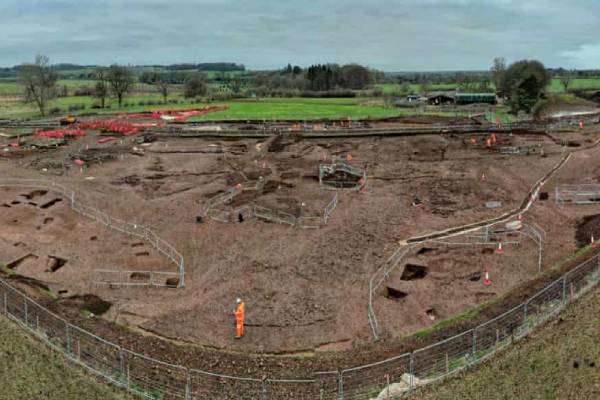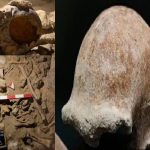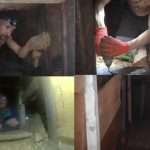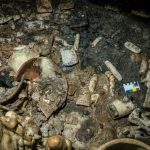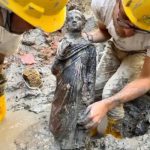A team of archaeologists have discovered artifacts and remnants of a Roman town during an excavation for a future high-speed train railway in England
The settlement, which is thought to have been founded around 400 BC and consisted of more than 30 roundhouses, grew during the Roman era in the years around 300-400 AD, with new stone buildings and roads emerging, according to evidence discovered during a dig near Chipping Warden.
Since 2018, over 100 archaeologists have examined the site between London and Birmingham, dubbed Blackgrounds after the black soil discovered there, with experts describing it as “one of the most impressive.”
Over 300 Roman coins were discovered by archaeologists along a wide road, implying that trade was important in the area as the village grew into a prosperous town.
The settlement was divided into domestic and industrial areas, with evidence of workshops, kilns, and wells, according to archaeologists.
Glass vessels, highly decorative pottery, jewelry, and even traces of the mineral galena – a substance crushed and mixed with oil to be used as make-up – were discovered during the dig, demonstrating the wealth of the inhabitants.
“The opportunity to carefully examine a site such as Blackgrounds, and map out a long history of the site, brought to life through artefacts, building remains, and roads, has enabled us to provide a more in-depth understanding of what life was like in rural south Northamptonshire in the Iron and Roman Age,” said Mike Court, lead archaeologist for HS2.
A team of archaeologists have discovered artifacts and remnants of a Roman town during an excavation for a future high-speed train railway in England
The settlement, which is thought to have been founded around 400 BC and consisted of more than 30 roundhouses, grew during the Roman era in the years around 300-400 AD, with new stone buildings and roads emerging, according to evidence discovered during a dig near Chipping Warden.
Since 2018, over 100 archaeologists have examined the site between London and Birmingham, dubbed Blackgrounds after the black soil discovered there, with experts describing it as “one of the most impressive.”
Over 300 Roman coins were discovered by archaeologists along a wide road, implying that trade was important in the area as the village grew into a prosperous town.
The settlement was divided into domestic and industrial areas, with evidence of workshops, kilns, and wells, according to archaeologists.
Glass vessels, highly decorative pottery, jewelry, and even traces of the mineral galena – a substance crushed and mixed with oil to be used as make-up – were discovered during the dig, demonstrating the wealth of the inhabitants.
“The opportunity to carefully examine a site such as Blackgrounds, and map out a long history of the site, brought to life through artefacts, building remains, and roads, has enabled us to provide a more in-depth understanding of what life was like in rural south Northamptonshire in the Iron and Roman Age,” said Mike Court, lead archaeologist for HS2.
A team of archaeologists have discovered artifacts and remnants of a Roman town during an excavation for a future high-speed train railway in England
The settlement, which is thought to have been founded around 400 BC and consisted of more than 30 roundhouses, grew during the Roman era in the years around 300-400 AD, with new stone buildings and roads emerging, according to evidence discovered during a dig near Chipping Warden.
Since 2018, over 100 archaeologists have examined the site between London and Birmingham, dubbed Blackgrounds after the black soil discovered there, with experts describing it as “one of the most impressive.”
Over 300 Roman coins were discovered by archaeologists along a wide road, implying that trade was important in the area as the village grew into a prosperous town.
The settlement was divided into domestic and industrial areas, with evidence of workshops, kilns, and wells, according to archaeologists.
Glass vessels, highly decorative pottery, jewelry, and even traces of the mineral galena – a substance crushed and mixed with oil to be used as make-up – were discovered during the dig, demonstrating the wealth of the inhabitants.
“The opportunity to carefully examine a site such as Blackgrounds, and map out a long history of the site, brought to life through artefacts, building remains, and roads, has enabled us to provide a more in-depth understanding of what life was like in rural south Northamptonshire in the Iron and Roman Age,” said Mike Court, lead archaeologist for HS2.
A team of archaeologists have discovered artifacts and remnants of a Roman town during an excavation for a future high-speed train railway in England
The settlement, which is thought to have been founded around 400 BC and consisted of more than 30 roundhouses, grew during the Roman era in the years around 300-400 AD, with new stone buildings and roads emerging, according to evidence discovered during a dig near Chipping Warden.
Since 2018, over 100 archaeologists have examined the site between London and Birmingham, dubbed Blackgrounds after the black soil discovered there, with experts describing it as “one of the most impressive.”
Over 300 Roman coins were discovered by archaeologists along a wide road, implying that trade was important in the area as the village grew into a prosperous town.
The settlement was divided into domestic and industrial areas, with evidence of workshops, kilns, and wells, according to archaeologists.
Glass vessels, highly decorative pottery, jewelry, and even traces of the mineral galena – a substance crushed and mixed with oil to be used as make-up – were discovered during the dig, demonstrating the wealth of the inhabitants.
“The opportunity to carefully examine a site such as Blackgrounds, and map out a long history of the site, brought to life through artefacts, building remains, and roads, has enabled us to provide a more in-depth understanding of what life was like in rural south Northamptonshire in the Iron and Roman Age,” said Mike Court, lead archaeologist for HS2.
A team of archaeologists have discovered artifacts and remnants of a Roman town during an excavation for a future high-speed train railway in England
The settlement, which is thought to have been founded around 400 BC and consisted of more than 30 roundhouses, grew during the Roman era in the years around 300-400 AD, with new stone buildings and roads emerging, according to evidence discovered during a dig near Chipping Warden.
Since 2018, over 100 archaeologists have examined the site between London and Birmingham, dubbed Blackgrounds after the black soil discovered there, with experts describing it as “one of the most impressive.”
Over 300 Roman coins were discovered by archaeologists along a wide road, implying that trade was important in the area as the village grew into a prosperous town.
The settlement was divided into domestic and industrial areas, with evidence of workshops, kilns, and wells, according to archaeologists.
Glass vessels, highly decorative pottery, jewelry, and even traces of the mineral galena – a substance crushed and mixed with oil to be used as make-up – were discovered during the dig, demonstrating the wealth of the inhabitants.
“The opportunity to carefully examine a site such as Blackgrounds, and map out a long history of the site, brought to life through artefacts, building remains, and roads, has enabled us to provide a more in-depth understanding of what life was like in rural south Northamptonshire in the Iron and Roman Age,” said Mike Court, lead archaeologist for HS2.
A team of archaeologists have discovered artifacts and remnants of a Roman town during an excavation for a future high-speed train railway in England
The settlement, which is thought to have been founded around 400 BC and consisted of more than 30 roundhouses, grew during the Roman era in the years around 300-400 AD, with new stone buildings and roads emerging, according to evidence discovered during a dig near Chipping Warden.
Since 2018, over 100 archaeologists have examined the site between London and Birmingham, dubbed Blackgrounds after the black soil discovered there, with experts describing it as “one of the most impressive.”
Over 300 Roman coins were discovered by archaeologists along a wide road, implying that trade was important in the area as the village grew into a prosperous town.
The settlement was divided into domestic and industrial areas, with evidence of workshops, kilns, and wells, according to archaeologists.
Glass vessels, highly decorative pottery, jewelry, and even traces of the mineral galena – a substance crushed and mixed with oil to be used as make-up – were discovered during the dig, demonstrating the wealth of the inhabitants.
“The opportunity to carefully examine a site such as Blackgrounds, and map out a long history of the site, brought to life through artefacts, building remains, and roads, has enabled us to provide a more in-depth understanding of what life was like in rural south Northamptonshire in the Iron and Roman Age,” said Mike Court, lead archaeologist for HS2.
A team of archaeologists have discovered artifacts and remnants of a Roman town during an excavation for a future high-speed train railway in England
The settlement, which is thought to have been founded around 400 BC and consisted of more than 30 roundhouses, grew during the Roman era in the years around 300-400 AD, with new stone buildings and roads emerging, according to evidence discovered during a dig near Chipping Warden.
Since 2018, over 100 archaeologists have examined the site between London and Birmingham, dubbed Blackgrounds after the black soil discovered there, with experts describing it as “one of the most impressive.”
Over 300 Roman coins were discovered by archaeologists along a wide road, implying that trade was important in the area as the village grew into a prosperous town.
The settlement was divided into domestic and industrial areas, with evidence of workshops, kilns, and wells, according to archaeologists.
Glass vessels, highly decorative pottery, jewelry, and even traces of the mineral galena – a substance crushed and mixed with oil to be used as make-up – were discovered during the dig, demonstrating the wealth of the inhabitants.
“The opportunity to carefully examine a site such as Blackgrounds, and map out a long history of the site, brought to life through artefacts, building remains, and roads, has enabled us to provide a more in-depth understanding of what life was like in rural south Northamptonshire in the Iron and Roman Age,” said Mike Court, lead archaeologist for HS2.
A team of archaeologists have discovered artifacts and remnants of a Roman town during an excavation for a future high-speed train railway in England
The settlement, which is thought to have been founded around 400 BC and consisted of more than 30 roundhouses, grew during the Roman era in the years around 300-400 AD, with new stone buildings and roads emerging, according to evidence discovered during a dig near Chipping Warden.
Since 2018, over 100 archaeologists have examined the site between London and Birmingham, dubbed Blackgrounds after the black soil discovered there, with experts describing it as “one of the most impressive.”
Over 300 Roman coins were discovered by archaeologists along a wide road, implying that trade was important in the area as the village grew into a prosperous town.
The settlement was divided into domestic and industrial areas, with evidence of workshops, kilns, and wells, according to archaeologists.
Glass vessels, highly decorative pottery, jewelry, and even traces of the mineral galena – a substance crushed and mixed with oil to be used as make-up – were discovered during the dig, demonstrating the wealth of the inhabitants.
“The opportunity to carefully examine a site such as Blackgrounds, and map out a long history of the site, brought to life through artefacts, building remains, and roads, has enabled us to provide a more in-depth understanding of what life was like in rural south Northamptonshire in the Iron and Roman Age,” said Mike Court, lead archaeologist for HS2.

